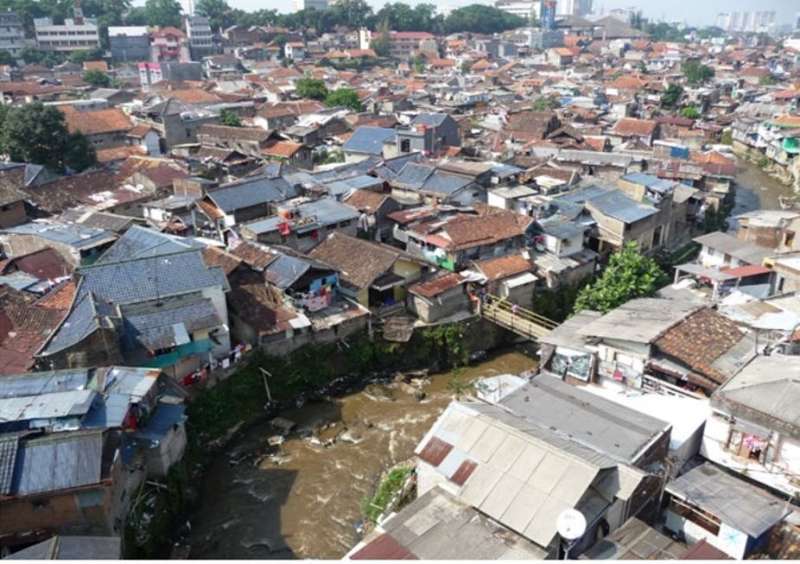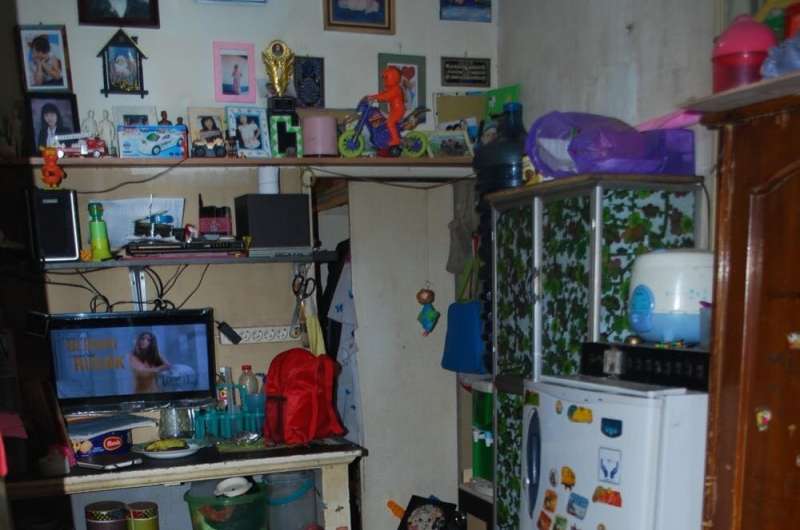In Indonesia, many of the urban poor live in crowded informal settlements and slums where “social distance is a luxury”. Paul Jones, Author provided
Around a quarter of the world's urban population—over 1 billion people – live in informal settlements and slums, the United Nations estimated in 2019. As the world confronts the COVID-19 pandemic, the urban poor living in these dense and overcrowded neighborhoods are at risk of contracting and spreading the coronavirus.
The World Health Organisation (WHO) recommends people:
- clean their hands often with water and soap or using alcohol-based hand rub
- maintain at least 1 meter distance from others
- avoid touching eyes, nose and mouths to prevent the spread of COVID-19.
But for communities living in dense areas with limited access to clean water, it's impossible to apply these middle-class preventive measures.
Many of the urban poor working in the informal sector are now also struggling to maintain their livelihoods. Their plight highlights the need to reaffirm that adequate housing, water supply and sanitation are basic human rights.
How COVID-19 affects the poor
Only as COVID-19 spreads in developing counties and infection rates and their geographical clusters become apparent are we seeing concerns for how disadvantaged urban dwellers in Asia will cope.
Asia is home to more than half of the world's urban population. Countries in the Asia-Pacific region have the world's biggest slums and informal settlements. They also have the largest concentrations of people living below the poverty line.
Indonesia, the world's fourth-most-populous country, has the most COVID-19 cases in Southeast Asia.
There is a concern that a surge in COVID-19 cases will have significant impacts on disadvantaged urban residents given their already unequal access to health facilities, affordable and adequate housing, and reduced livelihoods.
In Indonesia, many of the urban poor live in crowded informal settlements and slums known as kampungs. Here "social distance is a luxury".
The constrained size of housing and unbuilt space (such as alleyways), a lack of running water (and what water they have is often not to potable standards) and of sanitation contribute to poor environmental hygiene. It's a collective problem that makes widespread application of the WHO preventive measures simply unachievable.
As well, toilets and water are often shared as communal and public resources. That increases community vulnerability to transmission.
How poor urban residents can adapt
The solutions for Indonesia's kampung communities are multifaceted. They require new levels of collaboration.
Vulnerable kampungs must leverage their "community spirit" and social networks, governance arrangements and under-recognized adaptive capacity.
Small rooms in kampung housing provide many functions – sleeping, cooking, eating, laundry and general living area – highlighting the vulnerable infectious disease setting for family members. Credit: Ninik Suhartini, Bandung, Author provided
The best way to develop adaptive preventive measures is for kampung governance units—namely, rukun warga (RWs or community unit) and rukun tetangga (RTs or neighborhood unit) – to work with the local government. They should also involve influential community leaders, such as local mosque imams.
Strategically placing low-cost public water containers with soap holders throughout kampungs and community awareness programs are good examples of locally adapted measures by resilient and innovative communities.
"No one will be left behind'
Central tenets of the 2030 Agenda for Sustainable Development and the Sustainable Development Goals (SDGs), as adopted by 193 United Nations member states in 2015, was to ensure "no one will be left behind" and "to reach the furthest behind first".
These pledges were to direct governments and communities to take concerted action to eliminate poverty, urban inequality and discrimination.
The UN's New Urban Agenda (NUA) adopted in Quito, Ecuador, confirmed "no one will be left behind" as a primary principle.
A central platform of the NUA was a refocus on placing people, especially the urban disadvantaged, at the center of renewed efforts to manage urbanization. This included marginalized and excluded communities that live in informal settlements and slums.
The erratic spread of COVID-19 across many countries is exposing the depth and complexity of implementing these principles. More glaringly, it reveals how little has been done to assist the most vulnerable who live their lives in informal settlements and slums in the least developed countries.
What can leaders and educators do?
To reduce the impacts of the next inevitable pandemic, leaders at all levels should show the political will to implement new urban development models as promised in the NUA to confront both the scale and plight of the urban disadvantaged and marginalized.
Leaders must show greater commitment to understanding the concept of the "self-organized city"—the shaping and making of the informal city by myriad initiatives by the urban disadvantaged. If leaders and policymakers could see the city "through their eyes," they would understand the complexity of governance and rules that many kampungs, communities, residents and local leaders have adapted and evolved to meet their basic human needs and livelihoods. Just like the COVID-19 pandemic, these need to be built upon, not ignored or pushed to the bottom of possible preventive measures.
Academics and educators also have a pivotal role to play in challenging student curriculum, government and wider society mainstream concepts of informal settlements and slums.
For a long time, many informal settlements and slums have been seen as "parasites of the city," with policymakers wanting the "informal" to be "formalized." They do this by imposing "their" middle-class norms of how the urban disadvantaged should live their lives. This includes moving to high-rise settings, breaking up street-based social networks, and requiring new household monetary arrangements such as paying monthly rent, water and electricity bills.
This narrow view of realigning the city's "misfits" is akin to sterilizing communities whose physical structures, social norms and visual aesthetics and geometry do not conform with modernist and formal views of what the city should be and look like.
One key part of challenging "business as usual" is to change policy settings. This can be done through both teaching and research, using students and other city stakeholders to understand the rules, order and governance behind the "form of the informal" in kampungs.
Otherwise, the preoccupation with design, materiality and aesthetics—seen as paramount to create the modern global city "as it should be"—will continue to be disconnected from the needs of all city stakeholders, especially the growing cohort of urban disadvantaged.
Provided by The Conversation
This article is republished from The Conversation under a Creative Commons license. Read the original article.![]()

























